2024 | OriginalPaper | Buchkapitel
Identification of 3-D Landslide Displacement in the Outer Himalayas from Temporal High-Resolution Digital Surface Models Obtained Using Terrestrial Laser Scans
verfasst von : Ashok Anand, Chetan Gaur, Alok Bhardwaj
Erschienen in: Natural Geo-Disasters and Resiliency
Verlag: Springer Nature Singapore
Aktivieren Sie unsere intelligente Suche, um passende Fachinhalte oder Patente zu finden.
Wählen Sie Textabschnitte aus um mit Künstlicher Intelligenz passenden Patente zu finden. powered by
Markieren Sie Textabschnitte, um KI-gestützt weitere passende Inhalte zu finden. powered by
